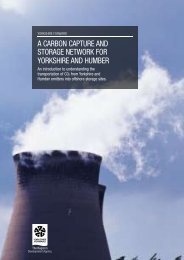Final report for One North East And NEPIC 21/12/10 - The Carbon ...
Final report for One North East And NEPIC 21/12/10 - The Carbon ...
Final report for One North East And NEPIC 21/12/10 - The Carbon ...
Create successful ePaper yourself
Turn your PDF publications into a flip-book with our unique Google optimized e-Paper software.
<strong>The</strong> case <strong>for</strong> a Tees CCS network<strong>Final</strong> Report<strong>The</strong>se are only initial high-level observations on how the network ownership anddevelopment could be structured in practice. Clearly, significant ef<strong>for</strong>t needs to take placeto be in a position to establish these types of arrangements, recognising the risk andfinancing challenges described previously (Section 7).Once established, the system could offer a reasonable amount of flexibility. Two of thescenarios would involve setting market entry requirements, which would offer scope <strong>for</strong>future exit and entry of direct participants and new market entrants. Furthermore, oncebuilt and proven, the equity holders could potentially exit and/or refinance, leveraging newsources of lower cost commercial debt (including mezzanine arrangements, structuredfinance), which could serve to lower financing costs.In practice, a structured and negotiated process will need to emerge that serves to bringthe JV partners along, requiring first the development of initial memoranda ofunderstanding, collaboration agreements, moving then towards letters of intent and finallystructured contracts and a SPV entity with its associated articles of incorporation andshareholder agreements.6.4 Tariff setting and market regulationWhere market entrants are potentially involved, there would be a need to establish tariffsetting procedures <strong>for</strong> entities connecting to the network. Four very basic models could beused:Capacity model. This would involve fully charging the entrants <strong>for</strong> their plannedcapacity, rather than throughput. It would insulate the pipeline operator from the nondeliveryrisk associated with technology failure or carbon and energy price economics.Full capital cost recovery could be achieved through this approach based the unitisedcapacity cost <strong>for</strong> whatever the period the capacity is contracted <strong>for</strong>. It is unlikely,however, to be an attractive proposition <strong>for</strong> market entrants as it exposes them to thefull cost of transport even in the event that they don‟t connect.Capacity plus throughput model. This involves pricing the service based on a mix ofcapacity and service. <strong>The</strong> precise ratio of each will be directly proportional to the levelof risk/insulation achieved by the network operator, as well as what the market couldtolerate.Throughput model. Pricing <strong>for</strong> services would be based entirely on the level of use ofthe pipeline by capturing entities. This approach fully exposes the network operator tonon-delivery risks, and would there<strong>for</strong>e likely involve adding a risk premium to thecharge.Take or pay agreements. <strong>The</strong>se would need to be in place between the networkoperator and either/or the offshore pipeline operator and/or the storage site operator.Clearly, the precise entry requirements and service costs will need careful negotiation.However, Tees Valley operators are well-versed in these type of contracting procedures,and could likely rapidly modify variants of existing agreements in order to establish theprecise nature of the contracts.In this context, previous studies on integrated network solutions have suggested that themarket may require a regulator to control monopolistic behaviour, and to avoid the risk ofone being established post-construction that could modify any agreements set out at thestart of the project. Previous studies suggested that this would build confidence of62







